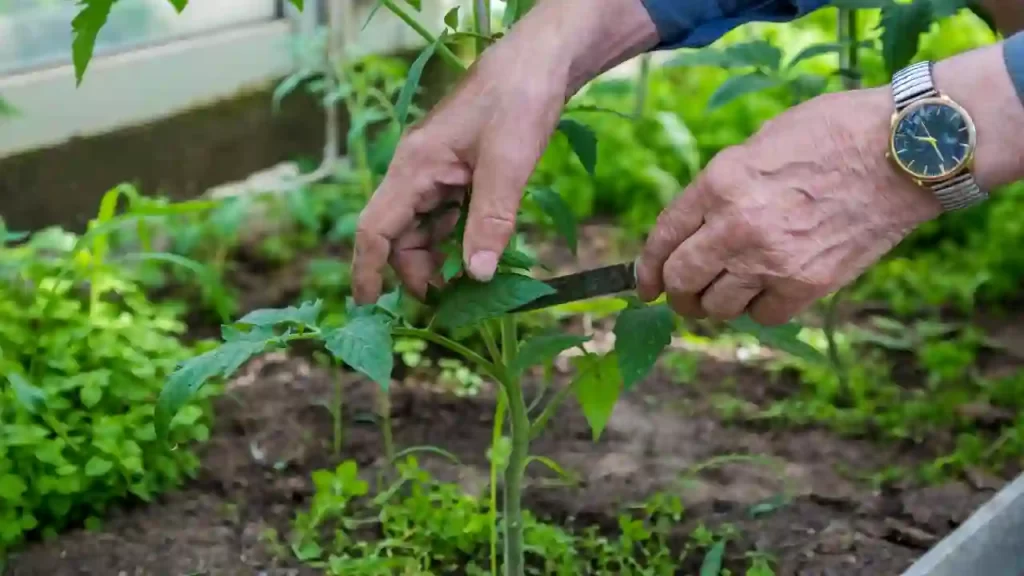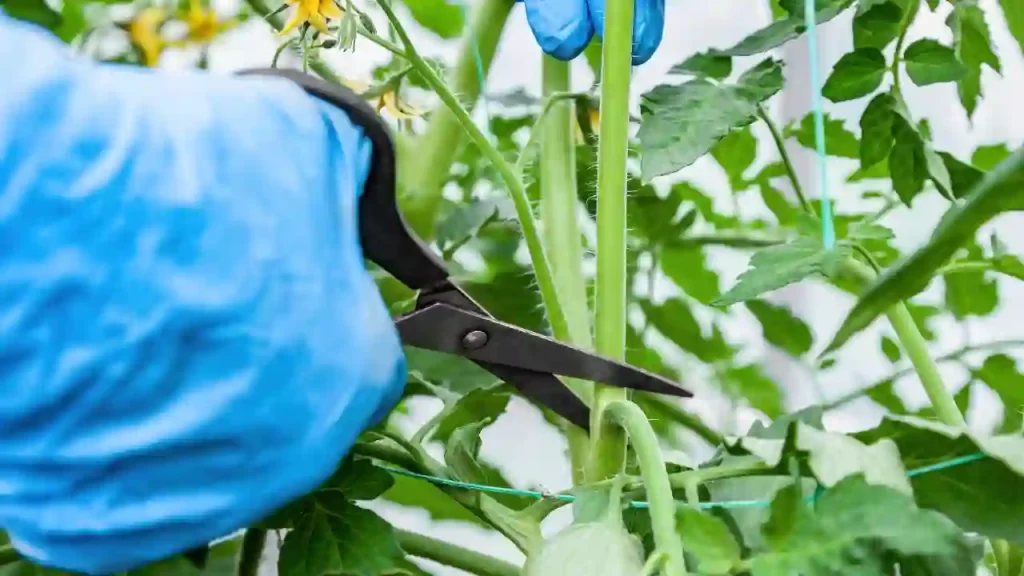Often tomato growers are confused about whether to prune or remove the tomato suckers or leave them to grow.
Keeping them has some advantages as well as some disadvantages. It also depends on the type of tomato plant which has been planted.
In short, Pruning tomato plant suckers is preferable in indeterminate varieties, whereas removing suckers for determinate varieties of tomatoes is not considered good.
Still, it depends on many factors, which I have briefly explained in the article below.
What are suckers on tomato plants?

Tomato suckers, also known as axillary or lateral shoots are small shoots formed in a V shape from the middle of the tomato plant’s main stem and branch. If these suckers are not removed or pruned, they can grow larger and form new branches, leading to bushy plants.
If these suckers are not managed properly, the plant can attract many pests and diseases as they turn bushy and dense.
The high number of leaves blocks the airflow in the plants and fruits. The emergence of suckers in both determinate plants and indeterminate tomato plants is a natural process.
Should You Remove Tomato Suckers?

If you find removing tomato suckers a big task, you can leave the tomato plant without removing its suckers. It is not necessary to compulsorily remove this. Still, it has certain advantages and disadvantages of pruning it.
Certain advantages of pruning tomato suckers are as follows:
- Large-size tomatoes are produced on the plants.
- Competition for nutrients is reduced, and plants become more focused on utilizing their energy to produce a high number of quality fruits.
- Pruning tomato plants also helps to improve airflow and reduce moisture, preventing the risk of various diseases in the plants.
- Pruning excessive leaves does not allow insects to reside in the plants.
Now the question is, what if the shooters are not pruned? Obviously, new branches are formed, and more tomatoes are produced, i.e., the plant produces a high yield.
Now it totally depends on you whether you want to go for bigger fruits that require pruning or you want a high yield that can be achieved without pruning.
It is good to remove suckers if you have planted indeterminate varieties of tomatoes, as this variety continuously produces fruits throughout the season.
On the other hand, determinate varieties of tomatoes grow up to a certain height, producing all their fruits at once.
Never mistake pruning the suckers for determinate varieties, as it can create a mess and reduce harvest.
Removing Suckers From Tomato Plants

Tomato suckers can be removed in various ways if you want to remove all the suckers and leave some of them on the main stem.
It is always considered best to remove suckers as and when spotted. If suckers are grown up to 2 inches, they can be easily seen and easily removed at this stage.
Hold the suckers and twist with your fingers and remove them. It can also be cut with the help of snipping tools or sharp pruning tools, and always sanitize the tools before use to avoid any damage.
Pruning can be done all around the season. At the same time, removing the bottom and brown shaded leaves is beneficial too. It helps the plants to be away from diseases.
Large leaves from fruits bunch should be pruned so that the development of the fruits is not interrupted.
Propagating Tomatoes From Suckers
The tomato shooters you removed can produce another tomato plant for you, so better if you don’t discard them.
The best thing about tomato roots is that they have an inherent capacity to grow at any point. Even the suckers can be used as a cutting to increase the number of tomato plants in your garden. Any tomato grower would be damn happy to grow tomatoes with more tomatoes on their plants.
A 6-inch cutting is considered best to produce a new plant. Simply remove all the leaves from the cutting and root them in water or soil.
Be cautious if the stem is rooted in water, and ensure no leaf is dipped in the water and only the bottom part is put in the water.
After your cutting is developed in a good root ball, this is the right time to plant it in a separate pot full of soil.
And when the plant is ready, you can transplant it outside safely and enjoy it when it starts developing flavorful tomatoes.
How often should you remove suckers?
As the tomato suckers can be easily removed, you need not worry about this process.
But I recommend removing them regularly and prefer to remove them every 7-10 days. It helps my plant to concentrate on utilizing its energy to produce more and larger tomatoes.
Should You Remove Side Shoots From Tomato Plants?

Removing side shoots (also known as suckers) from tomato plants is a common practice, and it can help promote healthier plant growth.
Removing side shoots helps to direct the plant’s energy into producing larger fruit rather than smaller, less flavorful ones.
Additionally, removing side shoots can prevent overcrowding in your front garden bed and increase airflow, reducing the risk of disease from setting in.
When removing side shoots, use clean pruning shears or scissors to avoid introducing diseases into the plant.
Take care not to damage the main stem as you remove the side shoots, and generally aim to remove only those below four inches in length.
If done correctly, removing side shoots can result in bigger and better tomatoes with an overall healthier plant.
However, it’s important to remember that removing side shoots isn’t necessary for all tomato plants.
Do all tomatoes need side shooting?
No, not all tomatoes need side shooting. Side shooting is a form of pruning that helps to encourage growth and improve the overall health of tomato plants. It can be beneficial for certain varieties of tomatoes, particularly determinate tomatoes, which tend to produce fewer fruits but with larger sizes.
However, it may not be necessary for indeterminate tomatoes, which often produce a larger number of smaller fruits.
It is important to research the particular variety of tomatoes you are growing to determine whether side shooting is necessary or beneficial.
Additionally, some gardeners prefer to avoid side shooting altogether as it can be time-consuming and may reduce overall yields.
Ultimately, whether or not to perform side shooting should be based on the specific conditions of your garden and the type of tomato you are growing.
Should you remove little branches from your tomato plant to help it grow?
Generally, pruning is not recommended for young tomato plants because it can weaken them and interfere with their growth.
If your tomato plant has grown strong enough to support several branches, then it may be beneficial to remove a few that are too close together or growing in an undesirable direction.
Pruning your tomato plant can also help it absorb more sunlight and air, which can improve its overall health. However, make sure to avoid pruning too much, as this could stress the plant and stunt its growth.
Furthermore, you should always ensure that any tools you use for pruning are clean and sterilized, as disease-causing bacteria can easily spread to other plants.
Pruning tomatoes is an important skill for most gardeners to learn, and with the proper attention, your tomato plant should remain healthy and productive all season long.
Which shoots to remove on tomato plants?
The best practice for tomato plants is to remove all the secondary shoots that appear in the leaf axils, starting about 6-8 weeks after transplanting. These are known as ‘suckers’ and can be identified by their smaller size and lack of flowers or fruits.
Removing these shoots helps direct more energy toward growing large tomatoes rather than many small ones.
Additionally, removing the shoots encourages the plant to become bushier and sturdier, which helps protect it from wind damage and other issues.
It is important to note that some tomato varieties don’t need secondary shoots removed. Determinate tomato plants grow to a predetermined height and then cease further development. In this case, leaving the secondary stems and shoots and letting them grow normally is best.
Finally, avoid pruning off the terminal shoot on a tomato plant since this is where all of the flowers and fruit will grow from. It is generally recommended that you only prune tomato plants or remove extra leaves if necessary to improve air circulation around the plant.
Should I remove lower stems from tomato plants?
Removing lower stems from tomato plants can be beneficial in some circumstances. When the tomato plant grows taller than desired, pruning off lower stems allows the remaining parts of the plant to receive more light and air. This helps promote healthy growth and better yields.
If a branch is too weak or damaged, it’s also best to remove this stem for the health of the plants.
Additionally, many gardeners may find it easier to harvest tomatoes or tie up vines when removing lower stems.
However, before you prune tomato suckers or any branches from the plant, be sure to check for any flowers or fruit growing on the lower stems. Removing these can reduce yields and harm the overall production and health of the plant.
Furthermore, if lower stems are removed too drastically, it can put a strain on the plant and cause it to become weak or even die. It’s best to trim back only what’s necessary and to leave as many healthy stems as possible.
Summary
Tomato suckers are grown naturally on tomato plants. In the above article, I have explained the consequences of both prunings and keeping these suckers. If it is removed, larger fruits are produced, and if not removed, a high yield can be seen. So it is totally up to you which option you want to choose.
But sometimes, it can create a huge mess for the plant as the plants become dense and busy if these suckers grow and are not removed. At the same time, tomato sucker, when removed, can be used as a cutting, and new plants can be produced.
Recent Posts
Are you ready to plant tomatoes for the best tomato harvest of your life? It all starts with getting the fertilizer right! Fertilizing tomatoes can seem daunting, but when done correctly, it’s...
9 Reasons Why Your Tomato Plants Wilting and How To Fix This!
When the gardeners see their lovely and precious tomato plants wilted, they become hopeless, sad, and impatient. But the situation can often be reversed with proper care and adopting a few good...

